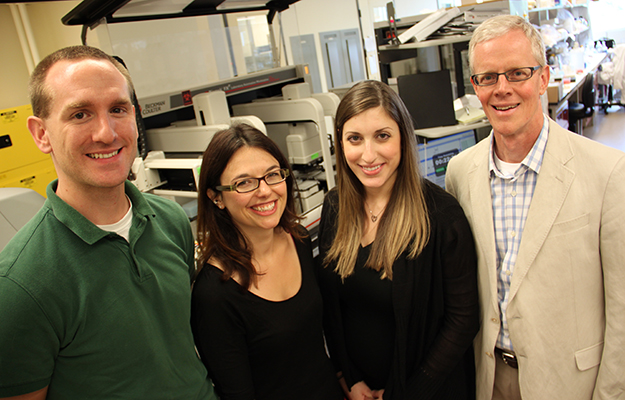A new way to fight antibiotic-resistant bacteria

From left: Chris Verschoor, a postdoctoral fellow in the Bowdish lab; assistant professor Dawn Bowdish; Maya Farha, a PhD candidate in the Brown lab; and professor Eric Brown gather at the Centre for Microbial Chemical Biology earlier this month.
At a time when scientists are quickly running out of options, McMaster researchers are using a new approach to fighting antibiotic-resistant bacteria.
The technique involves researchers in the Michael G. DeGroote Institute for Infectious Disease Research targeting the cell membranes of MRSA — a bacteria responsible for increasing the number of life-threatening infections both in hospitals and communities.
“Bacterial membranes have been relatively unexplored as targets for new antibiotics because of concerns of the potential for toxicity of membrane-active drugs,” said Eric Brown, a professor in the Department of Biochemistry and Biomedical Sciences.
Brown ultimately followed a suggestion from one of his students, Maya Farha. She suggested targeting bacterial membranes with various combinations of membrane-active chemicals that show synergy. In other words, two chemical compounds that together would have a greater effect and avoid toxicity.
“The bacterial membrane is a fundamental structure for energy production and storage in bacteria that functions like a battery,” said Brown. “We sought out two classes of chemicals in this work that could disrupt the ‘bacterial battery’ and found that when we combined them, they were wildly synergistic. Voila, a dead battery means no energy in the cell. And a bacterium with no energy is a dead bacterium.”
The McMaster discovery is an important one, because antibiotic-resistant bacteria are a growing public health threat worldwide. Scientists have been warning that the weakening arsenal against so-called “superbugs” could mean everyday infections could again become a major cause of death — just as they were before the discovery and development of penicillin in the late 1930s by the likes of Alexander Fleming.
“Every day, we are thinking about new ways to address this problem … and trying to take an innovative approach,” said Brown.
The World Health Organization (WHO) estimates the total cost of treating all hospital-borne antibiotic-resistant infections is about $10 billion a year. Tuberculosis, gonorrhea, malaria and childhood ear infections are just a few of the diseases that have become hard to treat with antibiotic drugs, largely because of overuse.
The research will appear in the Sept. 19 edition of Chemistry & Biology.

